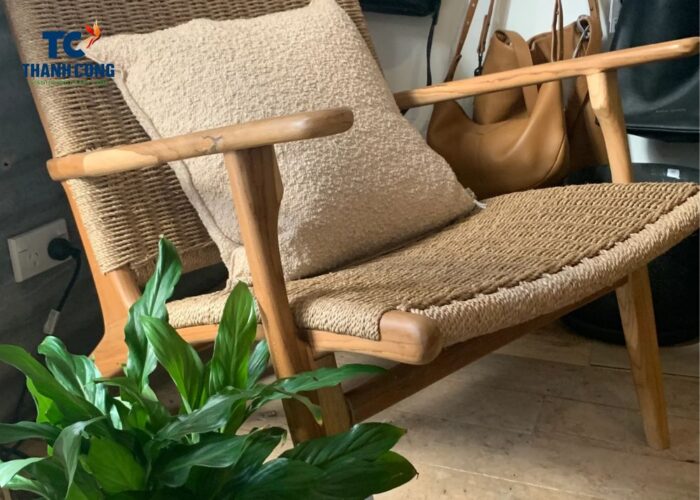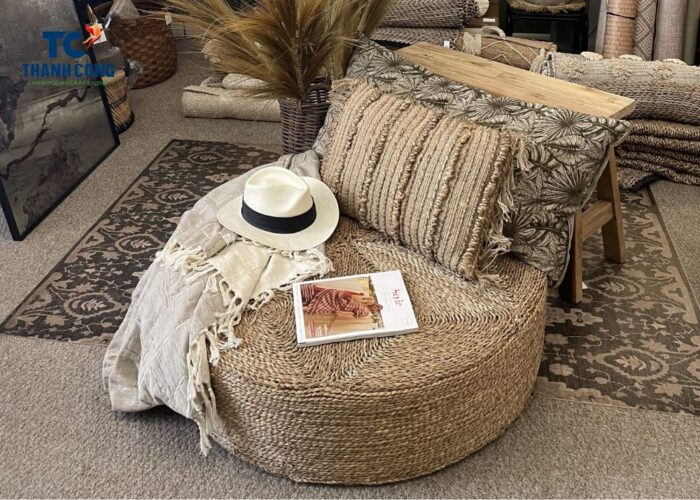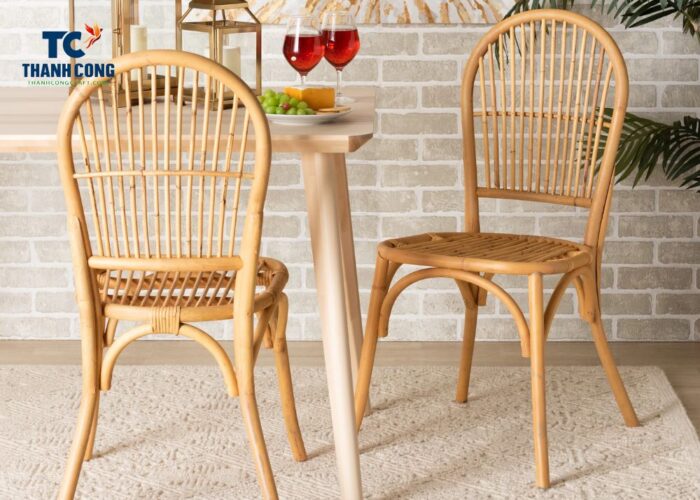Seagrass is a natural, durable and beautiful material that is used to make various types of furniture such as chairs, tables, baskets, rugs, etc.
However, seagrass can also be damaged by mold, termites, water, sunlight or improper use. How to restore seagrass furniture effectively and safely? This article will guide you through the basic steps to refresh your seagrass furniture.
Contents [hide]
1. Problems When Using Seagrass Furniture
Seagrass furniture is a popular choice for those who want to create an eco-friendly and natural living space. However, seagrass furniture also has some issues when using that you need to pay attention to.
Some common problems are:
- Seagrass furniture can get moldy if left in damp places or not dried thoroughly. This not only affects its appearance, but also can cause health problems for you and your family. You should wipe seagrass furniture regularly and keep it in a dry and airy place.

- Seagrass furniture can fade if exposed to direct sunlight: This can reduce its aesthetic value and make it look old and worn. You should avoid placing seagrass furniture in places with too bright light or cover it with curtains or fabric.
- Seagrass furniture can tear or peel off if hit hard or dragged: This can damage its structure and make it weak and unstable. You should handle seagrass furniture gently and not put heavy or sharp objects on it.
Seagrass furniture is a beautiful and sustainable product, but also needs to be cared for properly to maintain its quality and durability. You should follow the manufacturer’s instructions and use the appropriate cleaning products for seagrass furniture. In addition, you can also seek advice from experts on how to preserve seagrass furniture best.
2. How to Restore Seagrass Furniture?
2.1 Materials for Restoring Seagrass Furniture
How to repair seagrass furniture, restoring seagrass furniture often involves using specific materials to address various issues. Here are some materials commonly used in the restoration process:
- Soft Bristle Brush: Used for gently brushing and removing surface dirt and debris from seagrass fibers.
- Vacuum Cleaner: Equipped with a soft brush attachment, it helps remove dirt from the seagrass without causing damage.
- White Vinegar: Effective for cleaning and removing mold or mildew stains on seagrass furniture.
- Mild Soap: Gentle soap solutions are suitable for cleaning seagrass without causing damage to the fibers.

- Waterproof Sealer: Applied to protect seagrass furniture from water damage and stains. It helps repel water and liquids.
- Seagrass Twine or Cord: Used for reweaving or repairing loose or damaged seagrass strands.
- Seagrass Patch Kit: Includes replacement seagrass strands for repairing more extensive damage or areas with loose weaves.
- Fungicide or Mold Inhibitor: Used to treat and prevent mold or mildew growth on seagrass furniture.
- Fabric Protector Spray: Creates a protective barrier against stains and spills on seagrass.
- Wood Glue: Useful for reattaching loose or unraveled seagrass strands to the frame.
- Soft Cloths or Sponges: Used for applying cleaning solutions or sealers without causing damage to the seagrass fibers.
It’s important to note that the specific materials you need may vary based on the type and extent of damage to your seagrass furniture. Always follow manufacturer recommendations and test any cleaning, or restoration refinish product in an inconspicuous area before applying it to the entire piece.
2.2 Steps to Restore Seagrass Furniture
Restoring or refinishing seagrass furniture involves a systematic approach to address various issues and bring back its natural appeal. Here are step-by-step instructions on how to restore seagrass furniture:
Step 1: In-Depth Assessment
The initial phase of restoring seagrass furniture involves a meticulous examination. Scrutinize every aspect of the furniture, identifying structural damage, loose weaves, stains, and overall wear. This detailed assessment provides a clear roadmap for addressing specific issues during the restoration process.
Step 2: Cleaning – Revitalizing the Surface
In this step, employ a soft bristle brush or a vacuum cleaner with a gentle brush attachment to delicately eliminate surface dirt and debris from the seagrass furniture. For stubborn stains, concoct a solution using white vinegar and water, or opt for a mild soap.
Apply this solution gently to the affected areas, utilizing a soft cloth or sponge for careful cleaning. This process aims to rejuvenate the furniture’s surface while safeguarding the integrity of the seagrass fibers.
Step 3: Drying – Preserving Dryness
After cleaning, prioritize thorough drying. Position the cleaned furniture in a well-ventilated area or utilize fans to hasten the drying process. This crucial step is paramount for preventing mold growth, safeguarding the seagrass furniture’s longevity and structural integrity.
Step 4: Water Protection – Guarding Against Moisture
To shield your seagrass furniture from potential water damage, apply a waterproof sealer. Adhere closely to the manufacturer’s instructions for application, ensuring a thorough and even coverage. This protective measure fortifies the seagrass, enhancing its resilience against moisture and extending the life of your furniture.

Step 5: UV Protection – Safeguarding Against Sunlight
For seagrass furniture exposed to sunlight, safeguard it from fading by applying a sunblock or UV protectant. Adhere strictly to the product instructions to ensure effective shielding against the detrimental effects of UV rays on the seagrass fibers. This step preserves the vibrant appearance of your furniture and prolongs its aesthetic appeal.
Step 6: Repairing Loose Weaves – Restoring Structural Integrity
To address loose or unraveled seagrass strands, embark on careful reweaving. Employ seagrass twine and wood glue to securely reattach them to the frame. For more extensive repairs, consider utilizing a seagrass patch kit. This meticulous step is pivotal in restoring the furniture’s structural integrity and ensuring a seamless, enduring weave.
Step 7: Preventing Future Issues – Proactive Preservation
In anticipation of future challenges, contemplate applying fabric protector spray to establish a protective barrier against potential stains. Additionally, institute a regular cleaning and maintenance routine to thwart the recurrence of issues, ensuring the long-term vitality and aesthetic appeal of your seagrass furniture.
Remember to follow the specific care instructions for your seagrass furniture and test any cleaning or restoration products in an inconspicuous area before applying them more broadly. Regular maintenance will help extend the life and beauty of your restored seagrass furniture.
3. FAQs
3.1 Does Seagrass Fade? Does Seagrass Change Color?
Yes, seagrass can fade over time when exposed to prolonged sunlight. The natural fibers of seagrass are susceptible to the effects of ultraviolet (UV) rays, leading to a gradual change in color.
Initially, seagrass exhibits a vibrant and greenish hue, but extended exposure to sunlight can cause it to lose some of its color intensity, resulting in a faded appearance. To mitigate fading, it’s advisable to use UV protectants or keep seagrass furniture away from direct sunlight.
Regular maintenance and preventive measures can help preserve the natural beauty and color of seagrass over an extended period.
3.2 Is Seagrass Furniture Durable?
Yes, seagrass furniture is generally considered durable. Seagrass is a natural, robust material known for its strength and resilience. When properly cared for, seagrass furniture can withstand regular use and maintain its structural integrity for an extended period.
Its durability makes it a popular choice for various furniture items, including chairs, sofas, tables, and more. However, like any natural material, seagrass furniture requires appropriate care to maximize its longevity.
Avoiding excessive moisture, direct sunlight, and taking preventive measures against potential issues can contribute to the overall durability of seagrass furniture.
3.3 Can You Wash Seagrass Furniture?
Washing seagrass furniture requires careful consideration and a gentle approach. Seagrass is a natural material that can be sensitive to excessive moisture. Here are some general guidelines:
- Spot Cleaning: For small stains or spills, use a clean, damp cloth to gently blot the affected area. Avoid rubbing, as this can spread the stain.
- Mild Soap Solution: If more thorough cleaning is needed, you can create a solution of mild soap and water. Dampen a cloth in the soapy water and gently wipe the surface of the seagrass. Be sure not to saturate the material.
- Avoid Excessive Moisture: Seagrass is susceptible to damage from too much moisture, so it’s crucial to avoid using excessive water or cleaning solutions. Always wring out your cloth well and use a minimal amount of water.
- Drying: After cleaning, ensure the furniture is thoroughly dried. Place it in a well-ventilated area or use fans to expedite the drying process. This helps prevent mold growth.
In conclusion, the art of restoring seagrass furniture is a meticulous and rewarding process that breathes new life into these natural, charming pieces. By following the steps outlined in this guide on how to restore seagrass furniture, you not only revitalize its aesthetic appeal but also prolong its durability.
From the initial assessment of damages to the careful weaving and protective measures against future issues, each step plays a crucial role in the overall restoration journey.
If you have any further questions, don’t hesitate to send thanhcongcraft an email us at info@thanhcongcraft.com or message us at WhatsApp: +84967485411. Hope to serve you soon! Best regard!


